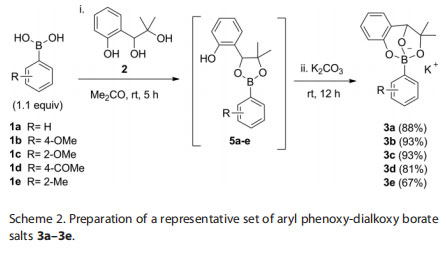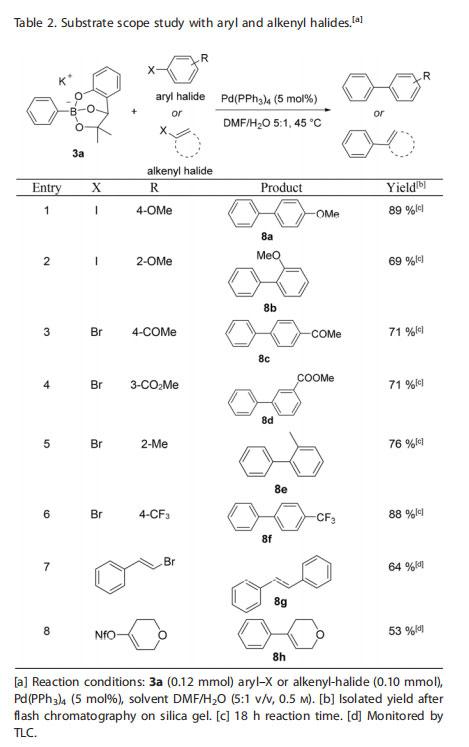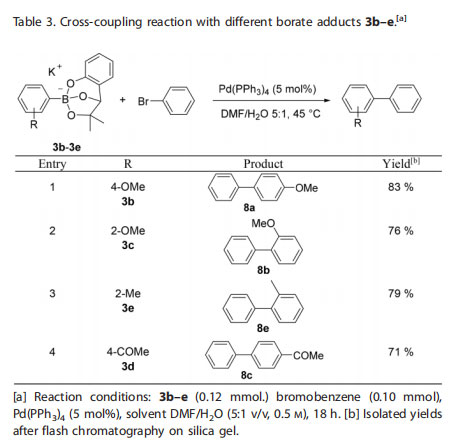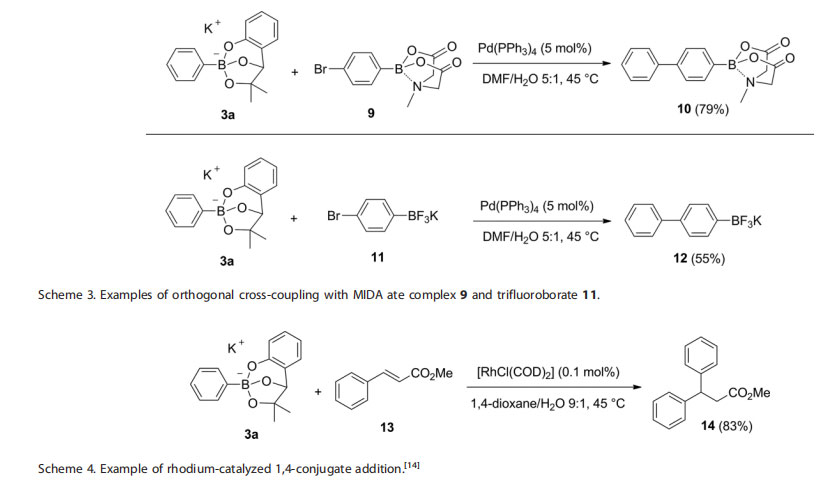200,000+ products from a single source!
sales@angenechem.com
Home > Phenoxy-Dialkoxy Borates as a New Class of Readily Prepared Preactivated Reagents for Base-Free Cross-Coupling
Phenoxy-Dialkoxy Borates as a New Class of Readily Prepared Preactivated Reagents for Base-Free Cross-Coupling
Marco Paladino,[a] Michele Boghi,[a] and Dennis G. Hall
Introduction
Several types of organoboron compounds can be employed as nucleophilic carbon-based reagents in transition metal-catalyzed processes, such as the popular Suzuki–Miyaura cross-coupling reaction.[1] Typically, the nucleophilic nature of the carbon-boron bond is revealed upon in situ formation of a tetrahedral boron species during the transition-metal-catalyzed reaction. Although many variants of this activation strategy have been exploited successfully, most notably with boronic acids, it still possesses limitations: 1. Often the tetrahedral boronate ion is a transient entity that is not isolated and requires
strongly basic conditions in order to form; 2. Some boronic acids are sensitive to oxidation or protodeboronation, therefore they require careful handling and storage; 3. Boronic acids tend to exist as mixtures containing various proportions of dehydrated anhydrides, such as as the 6-membered boroxines, which makes it challenging to determine their accurate stoichiometry. To address these problems, a number of ′masked′ boronic acids or preactivated adducts have been proposed (Figure 1). For example, air- and bench-stable trifluoroborate salts M[RBF3] (M = K or NR4) are solids that are easy to prepare, handle, and quantify.[2] On the other hand, they tend to display low solubility in many common organic solvents.[3]


Use of aqueous base is still required for their activation and coupling, and corrosive HF is released in the coupling process. Likewise, MIDA boronates are a stable class of protected boronic acid derivatives but they also require the use of a stoichiometric quantity of base as part of a slow-release mechanism.[4,5] In 2006, Cammidge and co-workers reported the preparation and characterization of discrete trihydroxy borate sodium salts (RB(OH)3– Na+) as isolable and stable reagents for use in the concept of direct base-free Suzuki–Miyaura cross-coupling.[6]
The absence of base is advantageous, however it is not known whether trihydroxyborate salts are orthogonal with other boron adducts such as trifluoroborate salts. Subsequently, Miyaura and co-workers reported the preparation and characterization of cyclic trialkoxyborates that can also be employed directly in base-free Suzuki–Miyaura cross-couplings and other C–C bondforming reactions (Figure 1).[7,8]
Whereas the reaction conditions for the cross-coupling are mild, the synthesis of the requisite trialkoxyborates from free boronic acids requires high temperatures (refluxing toluene) and a strong base (KOH), which is not ideal for thermosensitive and highly functionalized boronic acids. Consequently, there is a need for new types of stable, preactivated adducts that can be prepared with ease under mild reaction conditions, and that are easy to handle and soluble in most common organic solvents. Herein, we report the design, facile synthesis, and crosscoupling of a new class of phenoxy-dialkoxy adducts (3) of organoboronic acids (1) and triol 2 (Figure 1). These adducts form under ambient conditions, at a significantly lower temperature and with a weaker base compared to the conditions required
for the preparation of trialkoxyborates.

Results and Discussion
Triol 2 was selected because it possesses several key features for the purpose of this application: 1. It embeds a hindered 1,2-alkanediol group that demonstrates a high affinity for boronic acids; 2. It includes a phenoxy moiety which, with a lower pKa than a regular aliphatic alcohol, will allow a more facile deprotonation and concomitant quaternization of the boron atom;3. The aromatic ring can help increase the solubility of the resulting adducts in organic solvents. Triol 2 is easily synthesized from phenol as shown in Scheme 1. To this end, ortho-hydroxyalkylation with EtO2CCHO (ethyl glyoxalate) furnishes intermediate 4, which is reacted with MeMgCl to give the desired triol2.[9] The preparation of phenoxy-dialkoxy adducts is also straightforward, and the conditions were optimized using phenylboronic acid (Scheme 1). Thus, the boronic acid is condensed with triol 2 at room temperature in acetone, followed by addition of potassium carbonate to yield the desired triolborate 3a in high yield. The reaction is presumed to proceed through the formation of a boronic ester intermediate (e.g. 5a), which is then converted into the corresponding phenoxy-dialkoxy borate by deprotonation of the phenol, and concomitant cyclization with quaternization of the boron atom.
The potassium borate 3a was interchanged into the corresponding ammonium salt 6a, which was recrystallized to provide crystals suitable for X-ray crystallographic analysis (Figure 2).[10] In 6a, the length of the B–O bonds is 1.40–1.53 Å and 1.60 Å for the C–B bond. As expected from the loss of conjugation with the boron atom, these distances are significantly longer than the values observed in boronic acids (1.36–1.37 Å for B–O, and 1.57 Å for C–B)[11a] and pinacol boronic esters (1.31 Å for B–O, and 1.57 Å for C–B).[11b] The tetrahedral nature of the boron atom is clearly depicted in the ORTEP diagram: all of the C–B–O and O–B–O bond angles are relatively close to the expected value of 109 °. Quaternization of the boron center can also be inferred by NMR spectroscopy: 11B-NMR analysis reveals
a characteristic broad signal with upfield chemical shift, ca.δ = 7.5 ppm, typical of a negatively charged tetrahedral boron species.
To test the generality of the formation of phenoxy-dialkoxy borates, a prototypical set of arylboronic acids 1a–1e with various electronic and steric characteristics were condensed with triol 2 at room temperature in acetone, followed by addition of potassium carbonate to yield the desired triolborate salts 3a–e in high yields (Scheme 2). Most of the adducts 3a–3e are solids[12] that can be recrystallized with ease from diethyl ether. They are soluble in most organic solvents with the exception of halogenated hydrocarbons (i.e. dichloromethane and chloroform).
The application of phenoxy-dialkoxy boronates in base-free Pd-catalyzed Suzuki–Miyaura cross-coupling was assessed using as model substrates the phenyl borate salt 3a and p-iodoanisole(7) (Table 1). The formation of the expected coupling product 8a was optimized by examining the effect of temperature and solvent using Pd(OAc)2 as the pre-catalyst. From the results of Table 1, it is apparent that the reaction does not proceed at room temperature and requires gentle heating to 45 °C in order to reach completion within 18 hours when using triphenylphosphine as the ligand. A variety of solvents are tolerated, making this reaction suitable for both hydrophobic as well as more polar substrates (entries 5–9). As expected, the presence of water is crucial for a successful outcome.[7] Presumably, partial hydrolysis to a monohydroxyborate intermediate is required for an efficient transmetallation step. Initially, PPh3 was used as the ligand and since it gave satisfying results, commercially available Pd(PPh3)4 was selected as the catalyst for the substrate scope study.
With optimized cross-coupling conditions in hand, different aryl and alkenyl halides were evaluated. Aryl halides with electron-withdrawing or electron-donating substituents both led to a successful cross-coupling with the phenoxy-dialkoxyborate 3a (Table 2). Notably, more congested ortho-substituted aryl halides (entry 2 and entry 5) afforded the expected biphenyl products in good yields. Cross-coupling with alkenyl halides and pseudo-halides was also examined and the corresponding products were isolated in good yields (entry 7 and 8).

The same procedure was tested in the cross-coupling of a variety of aryl borates 3b–e with bromobenzene (Table 3). The expected biphenyl products were isolated in good yields. Remarkably, the more sterically hindered ortho-substituted aryl borates (entry 2 and 3) successfully underwent the cross-coupling reaction in very good yields. One attractive attribute of this new class of adducts of boronic acids is their potential chemical orthogonality with other boron containing reagents.[13] With this view in mind, we turned our attention to the para-bromoaryl MIDA boronate 9 and trifluoroborate salt 11, with the goal of evaluating their chemoselectivity with the phenoxy-dialkoxy borates. To our satisfaction, bifunctional substrates 9 and 11 underwent the crosscoupling reaction with 3a uneventfully, affording the desired biaryl boron adducts 10 and 12 in good yields (Scheme 3). The slower hydrolysis rate of the MIDA boronate and the requirement of a base to activate the trifluoroborate moiety enables chemoselective cross-coupling conditions where these groups remain unreactive throughout these transformations.

Lastly, with the goal of expanding the application of these new phenoxy-dialkoxy borates to other transition metal-catalyzed transformations, we tested the suitability of aryl borate 3a in a base-free rhodium catalyzed 1,4-conjugate addition.[14] In the event, the reaction with trans-methylcinnamate (13) proceeded smoothly under mild conditions, affording the expected biphenyl product 14 in good yield (Scheme 4).

Conclusions
In summary, we have developed a new class of phenoxy-dialkoxy borate adducts that can be employed as coupling partners in base-free Suzuki–Miyaura cross-coupling reactions. The ease of preparation using a milder base at room temperature along with their solubility in many of the commonly used organic solvents makes these phenoxy-dialkoxy adducts an advantageous alternative for base-sensitive substrates. Moreover, this methodology enables chemoselective cross-coupling reactions with other boron reagents such as MIDA esters and trifluoroborate salts. Finally, it has also been demonstrated that such boron complexes can be used for other base-free metal-catalyzed reactions, such as the rhodium-catalyzed 1,4-conjugate addition. We are planning to further expand the scope and applications
of this new and complementary class of boron reagents.
Conflict of interest
The authors declare no conflict of interest.
Acknowledgments
This work was funded by the Natural Sciences and Engineering Research Council (NSERC) of Canada (Discovery Grant to D. G. H.). We thank Dr. Michael J. Ferguson (X-ray Crystallography Laboratory, University of Alberta) for X-ray crystallographic analysis of compound 6a.
Angenechem offers custom synthesis of chemicals that are not commercially available:
CAS No. 101417-87-29,10-Anthracenedione, 1,5-bis[(2-chloro-2-propen-1-yl)oxy]- Catalog No.:AG0004GD MDL No.: MF:C20H14Cl2O4 MW:389.2288 |
CAS No. 101418-00-2Benzenesulfonic acid, 2-hydroxy-4-methyl-, polymer with formaldehyde Catalog No.:AG0004GC MDL No.:MFCD00869035 MF:C8H10O5S MW:218.2270 |
CAS No. 101418-02-4Carbamic acid, nitrosophenyl-, 1-methylethyl ester (9CI) Catalog No.:AG0004GB MDL No.: MF:C10H12N2O3 MW:208.2139 |
CAS No. 101418-04-6Ethanone, 1-[9-[3-(4-ethoxy-1-piperidinyl)propyl]-9H-carbazol-2-yl]-, monohydrochloride (9CI) Catalog No.:AG0004GA MDL No.: MF:C24H31ClN2O2 MW:414.9681 |
CAS No. 101418-08-09H-Carbazole, 9-[2-(1-piperidinyl)ethyl]-, hydrochloride (1:1) Catalog No.:AG0004G9 MDL No.: MF:C19H23ClN2 MW:314.8523 |
CAS No. 101418-11-5Carbonic acid, ethyl 1-methyl-4-phenyl-4-piperidinyl ester Catalog No.:AG0004G8 MDL No.: MF:C15H21NO3 MW:263.3321 |
CAS No. 101418-14-8Carbonic acid, methyl 1-methyl-4-phenyl-4-piperidinyl ester Catalog No.:AG0004G7 MDL No.: MF:C14H19NO3 MW:249.3056 |
CAS No. 101418-15-9Carbonic acid, 1-methyl-4-phenyl-4-piperidinyl phenyl ester Catalog No.:AG0004G6 MDL No.: MF:C19H21NO3 MW:311.3749 |
CAS No. 101418-32-0Methanimidic acid, N-[2-(diphenylmethoxy)ethyl]-, ethyl ester Catalog No.:AG0004G5 MDL No.: MF:C18H21NO2 MW:283.3648 |
CAS No. 101418-42-2Catalog No.:AG0004G4 MDL No.: MF:C26H28Cl2N8O14 MW:747.4517 |
CAS No. 101418-45-51,2-Ethanediamine, N1,N1-diethyl-N2,N2-diphenyl-, hydrochloride (1:1) Catalog No.:AG0004G3 MDL No.: MF:C18H25ClN2 MW:304.8575 |
CAS No. 101418-48-81,2-Ethanediamine, N1-[3-[4-(phenoxymethyl)phenyl]propyl]- Catalog No.:AG0004G2 MDL No.: MF:C18H24N2O MW:284.3960 |
CAS No. 101418-56-81,4-Butanedisulfonic acid, ion(2-) Catalog No.:AG0004G1 MDL No.: MF: MW: |
CAS No. 101418-85-3Diazene, 1-[2-(methylthio)phenyl]-2-phenyl- Catalog No.:AG0004G0 MDL No.: MF:C13H12N2S MW:228.3128 |
CAS No. 101418-87-5Diazene, 1-phenyl-2-[2-[(phenylmethyl)thio]phenyl]- Catalog No.:AG0004FZ MDL No.: MF:C19H16N2S MW:304.4087 |
CAS No. 101418-92-2Pyridinium, 2,3-dihydro-1,3,3-trimethyl-4-phenyl- Catalog No.:AG0004FY MDL No.: MF:C14H18N+ MW:200.2994 |
CAS No. 101419-68-5Lead, compd. with rubidium (9:4) Catalog No.:AG0004FX MDL No.: MF:Pb9Rb4 MW:2206.6712 |
CAS No. 101419-70-9Catalog No.:AG0004FW MDL No.:MFCD20624177 MF:C8H17Br MW:193.1246 |
CAS No. 101419-76-5Pyridine, 2-(4-fluorophenyl)-3-methyl- Catalog No.:AG0004FU MDL No.:MFCD09037513 MF:C12H10FN MW:187.2129 |
CAS No. 101419-78-73-Pyridinecarboxylic acid, 2-(4-fluorophenyl)- Catalog No.:AG0004FT MDL No.:MFCD14700037 MF:C12H8FNO2 MW:217.1958 |
CAS No. 101419-81-25H-Indeno[1,2-b]pyridin-5-one, 7-chloro- Catalog No.:AG0004FS MDL No.: MF:C12H6ClNO MW:215.6351 |
CAS No. 10142-37-7Benzoic acid, 3-[2-(4-amino-3-methoxyphenyl)diazenyl]-, sodium salt (1:1) Catalog No.:AG0004GG MDL No.: MF:C14H12N3NaO3 MW:293.2532 |
CAS No. 10142-57-1Dinaphth[2,3-a:2',3'-h]acridine-5,9,14,15,18(6H)-pentone Catalog No.:AG0004GF MDL No.: MF:C29H13NO5 MW:455.4172 |
CAS No. 10142-78-6Catalog No.:AG0004GE MDL No.: MF:C37H26N5Na2O6S2+ MW:746.7418 |
CAS No. 101420-28-41H-Imidazole, 2,2',2''-(methoxymethylidyne)tris[1-methyl- Catalog No.:AG0004H5 MDL No.: MF:C14H18N6O MW:286.3323 |
CAS No. 101420-62-63,4-Pyridinedicarboxylic acid, 5-chloro- Catalog No.:AG0004H4 MDL No.: MF:C7H4ClNO4 MW:201.5640 |
CAS No. 101420-67-11H-Indazole, 4-methyl-5-nitro- Catalog No.:AG0004H3 MDL No.:MFCD03787902 MF:C8H7N3O2 MW:177.1601 |
CAS No. 101420-79-5Catalog No.:AG0004H2 MDL No.:MFCD07783655 MF:C7H3IN2O2 MW:274.0154 |
CAS No. 101420-81-9Benzoic acid, 3-bromo-4-nitro- Catalog No.:AG0004H1 MDL No.:MFCD04117949 MF:C7H4BrNO4 MW:246.0150 |
CAS No. 101420-83-12,4,6-Cycloheptatrien-1-one, 2,6-dibromo- Catalog No.:AG0004H0 MDL No.: MF:C7H4Br2O MW:263.9141 |
CAS No. 101420-96-61H-Indazole, 5-chloro-4-nitro- Catalog No.:AG0004GZ MDL No.: MF:C7H4ClN3O2 MW:197.5786 |
CAS No. 101420-97-71H-Indazole, 7-chloro-4-nitro- Catalog No.:AG0004GY MDL No.: MF:C7H4ClN3O2 MW:197.5786 |
CAS No. 101420-98-81H-Indazole, 6-chloro-5-nitro- Catalog No.:AG0004GX MDL No.:MFCD08690109 MF:C7H4ClN3O2 MW:197.5786 |
CAS No. 101421-19-6Benzoic acid, 2,5-dibromo-4-hydroxy- Catalog No.:AG0004GW MDL No.: MF:C7H4Br2O3 MW:295.9129 |
CAS No. 101421-23-21H-Indazole, 5-chloro-6-nitro- Catalog No.:AG0004GV MDL No.: MF:C7H4ClN3O2 MW:197.5786 |
CAS No. 101421-31-2Catalog No.:AG0004GU MDL No.: MF:C7H4INO3 MW:277.0160 |
CAS No. 101421-62-9Benzene, 2-bromo-3,4-dimethyl-1-nitro- Catalog No.:AG0004GT MDL No.:MFCD01463598 MF:C8H8BrNO2 MW:230.0586 |
CAS No. 101421-63-0Benzene, 1-bromo-2,3-dimethyl-4-nitro- Catalog No.:AG0004GS MDL No.:MFCD09965954 MF:C8H8BrNO2 MW:230.0586 |
CAS No. 101421-70-9Catalog No.:AG0004GR MDL No.:MFCD19204920 MF:C8H7N3 MW:145.1613 |
CAS No. 101421-71-0Catalog No.:AG0004GQ MDL No.:MFCD10697885 MF:C8H7N3 MW:145.1613 |
CAS No. 101421-72-1Catalog No.:AG0004GP MDL No.:MFCD10697883 MF:C8H7N3 MW:145.1613 |
CAS No. 101421-73-2Catalog No.:AG0004GO MDL No.:MFCD10697884 MF:C8H7N3 MW:145.1613 |
CAS No. 101421-74-3Catalog No.:AG0004GN MDL No.: MF:C8H7N3 MW:145.1613 |
CAS No. 101421-76-53H-Pyrazol-3-one, 2,4-dihydro-5-(4-pyridinyl)- Catalog No.:AG0004GM MDL No.: MF:C8H7N3O MW:161.1607 |
CAS No. 101421-78-7Benzoic acid, 5-(aminocarbonyl)-2-hydroxy- Catalog No.:AG0004GL MDL No.: MF:C8H7NO4 MW:181.1455 |
CAS No. 101421-82-3Butanoic acid, 4-(acetylthio)- Catalog No.:AG0004GK MDL No.: MF:C6H10O3S MW:162.2068 |
CAS No. 101422-55-31H-Pyrrole-2,5-dione, 3,4-bis(4-bromophenyl)- Catalog No.:AG0004GJ MDL No.: MF:C16H9Br2NO2 MW:407.0562 |
CAS No. 101425-93-8Benzenepropanamine, N-hexyl-2-methoxy-, hydrochloride (1:1) Catalog No.:AG0004GI MDL No.: MF:C16H28ClNO MW:285.8526 |
CAS No. 101426-31-7Decanoic acid, 2-(4-methyl-5-thiazolyl)ethyl ester Catalog No.:AG0004GH MDL No.:MFCD09032915 MF:C16H27NO2S MW:297.4561 |
CAS No. 101426-85-12,4(1H,3H)-Pyrimidinedione, 3-cyclohexyl-5-(diethylamino)-1,6-dimethyl- Catalog No.:AG0004HL MDL No.: MF:C16H27N3O2 MW:293.4045 |
CAS No. 101429-87-22-Propenoic acid, 3-(3,4-dimethoxyphenyl)-, 3-methyl-2-buten-1-yl ester Catalog No.:AG0004HK MDL No.: MF:C16H20O4 MW:276.3276 |
CAS No. 10143-31-4Butanoic acid, 4-(dipropylamino)-4-oxo-, ethyl ester Catalog No.:AG0004HU MDL No.: MF:C12H23NO3 MW:229.3159 |
CAS No. 10143-32-52-Propanol, 1-(2-ethoxypropoxy)- Catalog No.:AG0004HT MDL No.: MF:C8H18O3 MW:162.2267 |
CAS No. 10143-40-5Catalog No.:AG0004HS MDL No.: MF:C13H14N2 MW:198.2637 |
CAS No. 10143-53-0Ethene, [2-(2-ethoxyethoxy)ethoxy]- Catalog No.:AG0004HR MDL No.: MF:C8H16O3 MW:160.2108 |
CAS No. 10143-60-9Heptane, 3,3'-[oxybis(methylene)]bis- Catalog No.:AG0004HQ MDL No.:MFCD00059427 MF:C16H34O MW:242.4406 |
CAS No. 10143-66-5Catalog No.:AG0004HP MDL No.: MF:C6H14O2 MW:118.1742 |
CAS No. 10143-67-62,5,7,10-Tetraoxaundecane, 6-methyl- Catalog No.:AG0004HO MDL No.:MFCD01733542 MF:C8H18O4 MW:178.2261 |
CAS No. 101431-40-7Benzene, 1-(1,1-dimethylethyl)-4-(phenylsulfonyl)- Catalog No.:AG0004HJ MDL No.: MF:C16H18O2S MW:274.3779 |
CAS No. 101432-05-71,2-Benzenediol, 4,4'-(1,4-butanediyl)bis- Catalog No.:AG0004HI MDL No.: MF:C16H18O4 MW:274.3117 |
CAS No. 101432-08-0Benzene, 1,1'-thiobis[2,6-dimethoxy- (9CI) Catalog No.:AG0004HH MDL No.: MF:C16H18O4S MW:306.3767 |
CAS No. 101432-45-51,1'-Biphenyl, 4,4'-bis(ethylthio)- Catalog No.:AG0004HG MDL No.: MF:C16H18S2 MW:274.4441 |
CAS No. 101433-23-2Catalog No.:AG0004HF MDL No.: MF:C16H34O2 MW:258.4400 |
CAS No. 101433-24-3Decane, 1-[2-(2-methylpropoxy)ethoxy]- Catalog No.:AG0004HE MDL No.: MF:C16H34O2 MW:258.4400 |
CAS No. 101433-27-6Octane, 1-[2-(2-butoxyethoxy)ethoxy]- Catalog No.:AG0004HD MDL No.: MF:C16H34O3 MW:274.4394 |
CAS No. 101433-28-7Octane, 1-[2-[2-(2-methylpropoxy)ethoxy]ethoxy]- Catalog No.:AG0004HC MDL No.: MF:C16H34O3 MW:274.4394 |
CAS No. 101433-38-9Catalog No.:AG0004HB MDL No.:MFCD00093677 MF:C16H35BO2 MW:270.2589 |
CAS No. 101433-55-0Acetamide, N-(6-amino-1,2,3,4-tetrahydro-1,3-dimethyl-2,4-dioxo-5-pyrimidinyl)-2-(dibutylamino)- Catalog No.:AG0004HA MDL No.: MF:C16H29N5O3 MW:339.4332 |
CAS No. 101438-17-98-Azabicyclo[3.2.1]octan-3-amine, 8-methyl-N-(2-phenylethyl)- Catalog No.:AG0004H9 MDL No.:MFCD04116070 MF:C16H24N2 MW:244.3752 |
CAS No. 101439-14-94H-Pyran-4-thione, 2-(4-bromophenyl)-6-phenyl- Catalog No.:AG0004H8 MDL No.: MF:C17H11BrOS MW:343.2376 |
CAS No. 101439-76-3Benzoic acid, 4-[4-oxo-5-(phenylmethylene)-2-thioxo-3-thiazolidinyl]- Catalog No.:AG0004H7 MDL No.: MF:C17H11NO3S2 MW:341.4041 |
CAS No. 101439-83-2Benzoic acid, 4-[(1,4-dihydro-3-hydroxy-1,4-dioxo-2-naphthalenyl)amino]- Catalog No.:AG0004H6 MDL No.: MF:C17H11NO5 MW:309.2729 |
CAS No. 10144-33-9L-Aspartic acid, N-acetyl-, 4-(phenylmethyl) ester Catalog No.:AG0004HN MDL No.: MF:C13H14NO5- MW:264.2540 |
CAS No. 10144-63-52-Propanone, 1-[4-(acetyloxy)-3-methoxyphenyl]- Catalog No.:AG0004HM MDL No.: MF:C12H14O4 MW:222.2372 |
CAS No. 101440-35-1Catalog No.:AG0004IG MDL No.: MF:C16H35P MW:258.4229 |
CAS No. 101440-64-64(3H)-Quinazolinone, 3-(4-bromophenyl)-2-propyl- Catalog No.:AG0004IF MDL No.: MF:C17H15BrN2O MW:343.2178 |
CAS No. 101441-53-6Catalog No.:AG0004IE MDL No.: MF:C17H15N MW:233.3077 |
CAS No. 101442-35-74H-1-Benzopyran-4-one, 2-[4-(dimethylamino)phenyl]-3-hydroxy- Catalog No.:AG0004ID MDL No.: MF:C17H15NO3 MW:281.3059 |
CAS No. 101442-38-0Methanone, (3,4-dimethoxyphenyl)-1H-indol-1-yl- Catalog No.:AG0004IC MDL No.: MF:C17H15NO3 MW:281.3059 |
CAS No. 101443-57-6Butanoic acid, 4,4-dibutoxy-, butyl ester Catalog No.:AG0004IB MDL No.: MF:C16H32O4 MW:288.4229 |
CAS No. 101444-37-54(5H)-Thiazolone, 5-[(4-methylphenyl)methylene]-2-(phenylamino)- Catalog No.:AG0004IA MDL No.: MF:C17H14N2OS MW:294.3709 |
CAS No. 101444-89-7Benzoic acid, 4-[[3-[(4-carboxyphenyl)amino]-2-propen-1-ylidene]amino]- Catalog No.:AG0004I9 MDL No.: MF:C17H14N2O4 MW:310.3041 |
CAS No. 101446-68-8Naphthalene, 1-[[(4-chlorophenyl)thio]methyl]- Catalog No.:AG0004I8 MDL No.: MF:C17H13ClS MW:284.8031 |
CAS No. 101447-69-2Benzene, 1,4-dimethoxy-2-octyl- Catalog No.:AG0004I7 MDL No.: MF:C16H26O2 MW:250.3764 |
CAS No. 101447-92-1Catalog No.:AG0004I6 MDL No.: MF:C16H26O2 MW:250.3764 |
CAS No. 101448-09-3Benzene, (1,3,3-triethoxy-1-methylpropyl)- Catalog No.:AG0004I5 MDL No.: MF:C16H26O3 MW:266.3758 |
CAS No. 101448-33-3Peroxide, bis(cycloheptylcarbonyl) (6CI,9CI) Catalog No.:AG0004I4 MDL No.: MF:C16H26O4 MW:282.3752 |
CAS No. 10145-04-7Benzenemethanol, α-(aminomethyl)-3,4-difluoro- Catalog No.:AG0004IJ MDL No.:MFCD09042070 MF:C8H9F2NO MW:173.1600 |
CAS No. 10145-97-8D-Alanine, L-alanyl-L-alanyl-L-alanyl-L-alanyl- Catalog No.:AG0004IH MDL No.: MF:C15H27N5O6 MW:373.4048 |
CAS No. 101451-35-89H-Fluorene-9-carboxylic acid, 9-(2-propen-1-yl)- Catalog No.:AG0004I3 MDL No.: MF:C17H14O2 MW:250.2919 |
CAS No. 101451-69-89,10-Anthracenedione, 2-(ethoxymethyl)-1-hydroxy- Catalog No.:AG0004I2 MDL No.: MF:C17H14O4 MW:282.2907 |
CAS No. 101451-75-62H-1-Benzopyran-2-one, 6-methoxy-7-(phenylmethoxy)- Catalog No.:AG0004I1 MDL No.: MF:C17H14O4 MW:282.2907 |
CAS No. 101452-11-32,2'-Bithiophene, 5-methyl-5'-(2-phenylethenyl)- Catalog No.:AG0004I0 MDL No.: MF:C17H14S2 MW:282.4231 |
CAS No. 101452-64-6Urea, N-cyclohexyl-N'-(1,1,3,3-tetramethylbutyl)- Catalog No.:AG0004HZ MDL No.: MF:C15H30N2O MW:254.4115 |
CAS No. 101452-66-8Catalog No.:AG0004HY MDL No.: MF:C15H30N2O2 MW:270.4109 |
CAS No. 101452-98-6Catalog No.:AG0004HX MDL No.: MF:C15H30O2 MW:242.3975 |
CAS No. 101452-99-7Catalog No.:AG0004HW MDL No.: MF:C15H30O2 MW:242.3975 |
CAS No. 101453-05-8Oxirane, 2-[[(2-butyloctyl)oxy]methyl]- Catalog No.:AG0004HV MDL No.: MF:C15H30O2 MW:242.3975 |
CAS No. 101455-63-4Silanamine, 1,1,1-trimethyl-N-[2,4,6-tris(1,1-dimethylethyl)phenyl]- Catalog No.:AG0004J1 MDL No.: MF:C21H39NSi MW:333.6266 |
CAS No. 101456-16-0Phosphonic acid, [hydroxy(4-nitrophenyl)methyl]-, diphenyl ester (9CI) Catalog No.:AG0004J0 MDL No.: MF:C19H16NO6P MW:385.3072 |
CAS No. 101456-22-8Benzenamine, N-methyl-4-[2-(4-nitrophenyl)ethynyl]- Catalog No.:AG0004IZ MDL No.: MF:C15H12N2O2 MW:252.2680 |
CAS No. 101458-39-32(3H)-Furanone, dihydro-5,5-dimethyl-3-(phenylmethylene)-, (3E)- Catalog No.:AG0004IY MDL No.: MF:C13H14O2 MW:202.2491 |
CAS No. 101459-67-01,4-Benzenediol, 2-(1-methyl-2-propen-1-yl)- Catalog No.:AG0004IX MDL No.: MF:C10H12O2 MW:164.2011 |
CAS No. 10146-32-49,10-Anthracenedione, 6-chloro-1,4-bis(cyclohexylamino)- Catalog No.:AG0004J7 MDL No.: MF:C26H29ClN2O2 MW:436.9737 |
CAS No. 10146-51-79,10-Anthracenedione, 1-amino-3-methyl- Catalog No.:AG0004J6 MDL No.: MF:C15H11NO2 MW:237.2533 |
CAS No. 10146-54-09,10-Anthracenedione, 1,5-diamino-2-methyl- Catalog No.:AG0004J5 MDL No.: MF:C15H12N2O2 MW:252.2680 |
CAS No. 10146-55-19,10-Anthracenedione, 1,8-diamino-2-methyl- Catalog No.:AG0004J4 MDL No.: MF:C15H12N2O2 MW:252.2680 |
CAS No. 10146-89-1Cholestane-2,3-diol, (2β,3β,5α)- Catalog No.:AG0004J3 MDL No.: MF:C27H48O2 MW:404.6688 |
CAS No. 10146-98-22,4(1H,3H)-Pyrimidinedione, 5,5'-methylenebis[6-amino-1,3-dimethyl- Catalog No.:AG0004J2 MDL No.: MF:C13H18N6O4 MW:322.3198 |
CAS No. 101460-12-22-Pyrimidinamine, 4-phenyl-6-(1-piperidinyl)- Catalog No.:AG0004IW MDL No.: MF:C15H18N4 MW:254.3302 |
CAS No. 101460-22-4Benzoic acid, 3-bromo-2,5,6-trimethoxy- Catalog No.:AG0004IV MDL No.:MFCD00191620 MF:C10H11BrO5 MW:291.0953 |
CAS No. 101460-36-0Benzamide, 3-bromo-N-[[(2S)-1-ethyl-2-pyrrolidinyl]methyl]-5-hydroxy-2,6-dimethoxy- Catalog No.:AG0004IU MDL No.: MF:C16H23BrN2O4 MW:387.2688 |
CAS No. 1014613-05-81H-Pyrrolo[2,3-b]pyridine, 4-bromo-2-methyl-1-(phenylsulfonyl)- Catalog No.:AG0004IP MDL No.:MFCD13191645 MF:C14H11BrN2O2S MW:351.2183 |
CAS No. 1014613-31-0Catalog No.:AG0004IO MDL No.: MF:C20H23BN2O4S MW:398.2836 |
CAS No. 1014613-64-91H-Pyrrolo[2,3-b]pyridine, 4-bromo-2-methyl- Catalog No.:AG0004IN MDL No.:MFCD15529172 MF:C8H7BrN2 MW:211.0586 |
CAS No. 1014614-07-3Boronic acid, B-(2-methyl-1H-pyrrolo[2,3-b]pyridin-4-yl)- Catalog No.:AG0004IM MDL No.:MFCD16036274 MF:C8H9BN2O2 MW:175.9803 |
CAS No. 1014614-11-91H-Pyrrolo[2,3-b]pyridine, 4-bromo-2-cyclopropyl- Catalog No.:AG0004IL MDL No.:MFCD15529170 MF:C10H9BrN2 MW:237.0959 |
CAS No. 101462-56-0Cholesten-3-ol, (3β,5α)- (9CI) Catalog No.:AG0004IT MDL No.: MF:C27H46O MW:386.6535 |
CAS No. 101462-63-91-Propanone, 1-(naphthalenyl)- Catalog No.:AG0004IS MDL No.: MF:C13H12O MW:184.2338 |
CAS No. 101463-63-2Benzenamine, 4-[2-chloro-4-(trifluoromethyl)phenoxy]-2-fluoro- Catalog No.:AG0004IR MDL No.: MF:C13H8ClF4NO MW:305.6553 |
CAS No. 1014630-98-85-Thiazolecarboxylic acid, 2-(2-pyrimidinyl)- Catalog No.:AG0004IK MDL No.:MFCD12093747 MF:C8H5N3O2S MW:207.2092 |
CAS No. 1014631-26-54-Thiazolecarboxylic acid, 2-(2-pyrimidinyl)- Catalog No.:AG0004JK MDL No.:MFCD12093744 MF:C8H5N3O2S MW:207.2092 |
CAS No. 1014631-58-31H-Pyrazole-3-carboxylic acid, 1-(2-pyridinyl)- Catalog No.:AG0004JJ MDL No.:MFCD11040399 MF:C9H7N3O2 MW:189.1708 |
CAS No. 1014631-89-01H-Pyrazole-4-carboxylic acid, 1-(3-pyridinyl)- Catalog No.:AG0004JI MDL No.:MFCD18260889 MF:C9H7N3O2 MW:189.1708 |
CAS No. 1014631-92-51H-Pyrazole-4-carboxylic acid, 1-(4-pyridinyl)-, ethyl ester Catalog No.:AG0004JH MDL No.:MFCD20275539 MF:C11H11N3O2 MW:217.2239 |
CAS No. 1014632-12-21H-Pyrazole-4-carboxylic acid, 1-(2-pyrazinyl)-, ethyl ester Catalog No.:AG0004JG MDL No.:MFCD24119667 MF:C10H10N4O2 MW:218.2120 |
CAS No. 1014632-18-81H-Pyrazole-4-carboxylic acid, 1-(2-pyrimidinyl)- Catalog No.:AG0004JF MDL No.:MFCD12192706 MF:C8H6N4O2 MW:190.1588 |
CAS No. 1014644-76-83-Thiophenecarboxaldehyde, 2-bromo-5-chloro- Catalog No.:AG0004JE MDL No.: MF:C5H2BrClOS MW:225.4908 |
CAS No. 1014645-75-04-(1-Aminocyclopropyl)benzonitrile Catalog No.:AG0004JD MDL No.:MFCD11616338 MF:C10H10N2 MW:158.1998 |
CAS No. 1014645-87-4Benzoic acid, 4-(1-aminocyclopropyl)-, methyl ester, hydrochloride (1:1) Catalog No.:AG0004JC MDL No.:MFCD11616336 MF:C11H14ClNO2 MW:227.6874 |
CAS No. 101465-37-6Acetamide, 2-[bis(methylphenyl)phosphinyl]-N,N-diethyl- (9CI) Catalog No.:AG0004JT MDL No.: MF:C20H26NO2P MW:343.3997 |
CAS No. 101465-44-5Phenol, dimethyl(1-methylpropyl)- (9CI) Catalog No.:AG0004JS MDL No.: MF:C12H18O MW:178.2707 |
CAS No. 101466-25-51,3-Propanediamine, N3-(3,3-dimethoxypropyl)-N1,N1-dimethyl- Catalog No.:AG0004JR MDL No.: MF:C10H24N2O2 MW:204.3098 |
CAS No. 101466-85-72-Propenoic acid, 3-[4-(trifluoromethyl)phenyl]-, ethyl ester Catalog No.:AG0004JQ MDL No.:MFCD09258679 MF:C12H11F3O2 MW:244.2097 |
CAS No. 101467-40-76-Isoquinolinol, 1,2,3,4-tetrahydro-7-methoxy-1-methyl-, (1R)- Catalog No.:AG0004JP MDL No.: MF:C11H15NO2 MW:193.2423 |
CAS No. 101467-70-34H-1-Benzopyran-4-one, 5,7-dihydroxy-3-[(4-hydroxyphenyl)methyl]- Catalog No.:AG0004JO MDL No.: MF:C16H12O5 MW:284.2635 |
CAS No. 101468-13-72H-1-Benzopyran-2-one, 3-amino-4-(diethylamino)- Catalog No.:AG0004JN MDL No.: MF:C13H16N2O2 MW:232.2783 |
CAS No. 101468-18-2Formamide, N-(1-tricyclo[3.3.1.13,7]dec-1-ylpropyl)- Catalog No.:AG0004JM MDL No.: MF:C14H23NO MW:221.3385 |
CAS No. 101469-91-42,5-Pyrrolidinedione, 3-hydroxy-1-(phenylmethyl)-, (3S)- Catalog No.:AG0004JL MDL No.:MFCD08275390 MF:C11H11NO3 MW:205.2099 |
CAS No. 10147-02-1Propanedinitrile, 2-(2,3-dihydro-4(1H)-quinolinylidene)- Catalog No.:AG0004JV MDL No.: MF:C12H9N3 MW:195.2200 |
CAS No. 10147-03-2Propanedinitrile, 2-(4-quinolinyl)- Catalog No.:AG0004JU MDL No.: MF:C12H7N3 MW:193.2041 |
CAS No. 10147-11-2Catalog No.:AG0004KH MDL No.:MFCD00134431 MF:C9H8 MW:116.1598 |
CAS No. 10147-36-1Catalog No.:AG0004KG MDL No.:MFCD00007462 MF:C3H7ClO2S MW:142.6045 |
CAS No. 10147-37-2Catalog No.:AG0004KF MDL No.:MFCD00007453 MF:C3H7ClO2S MW:142.6045 |
CAS No. 10147-40-7Catalog No.:AG0004KE MDL No.:MFCD00014728 MF:C12H25ClO2S MW:268.8437 |
CAS No. 10147-41-8Catalog No.:AG0004KD MDL No.:MFCD00051521 MF:C18H37ClO2S MW:353.0032 |
CAS No. 10147-53-2Androstan-3-one, 17-hydroxy-4-methyl-, (4α,5α,17β)- Catalog No.:AG0004KC MDL No.: MF:C20H32O2 MW:304.4669 |
CAS No. 10147-68-9Acetamide, 2-chloro-N-(2-hydroxyphenyl)- Catalog No.:AG0004KB MDL No.:MFCD00086381 MF:C8H8ClNO2 MW:185.6076 |
CAS No. 10147-69-0Acetamide, 2-chloro-N-(3-hydroxyphenyl)- Catalog No.:AG0004KA MDL No.:MFCD00709261 MF:C8H8ClNO2 MW:185.6076 |
CAS No. 10147-70-3Acetamide, 2-chloro-N-(2-nitrophenyl)- Catalog No.:AG0004K9 MDL No.:MFCD00024201 MF:C8H7ClN2O3 MW:214.6058 |
CAS No. 10147-71-4Acetamide, 2-chloro-N-(3-nitrophenyl)- Catalog No.:AG0004K8 MDL No.:MFCD00024359 MF:C8H7ClN2O3 MW:214.6058 |
CAS No. 10147-75-8[1,1'-Biphenyl]-4,4'-diamine, 3,3'-dichloro-N4,N4'-bis(phenylmethylene)- Catalog No.:AG0004K7 MDL No.: MF:C26H18Cl2N2 MW:429.3405 |
CAS No. 101470-16-0Catalog No.:AG0004K6 MDL No.: MF:C13H19N3O6S MW:345.3715 |
CAS No. 101470-23-91-Naphthalenol, 5,6,7,8-tetrahydro-6-(propylamino)-, (6S)- Catalog No.:AG0004K5 MDL No.: MF:C13H19NO MW:205.2961 |
CAS No. 101470-81-92-Butanol, 3-methyl-4-[(phenylmethoxy)methoxy]-, (2S,3R)- Catalog No.:AG0004K4 MDL No.: MF:C13H20O3 MW:224.2961 |
CAS No. 1014701-61-1Catalog No.:AG0004JZ MDL No.: MF: MW: |
CAS No. 101471-20-9Benzenamine, 2-bromo-4,6-difluoro-, hydrobromide (1:1) Catalog No.:AG0004K3 MDL No.:MFCD00236594 MF:C6H5Br2F2N MW:288.9154 |
CAS No. 101471-73-22-Propenoic acid, 3-(4-morpholinyl)-, methyl ester, (2E)- Catalog No.:AG0004K2 MDL No.:MFCD01696261 MF:C8H13NO3 MW:171.1937 |
CAS No. 1014712-76-53-Oxa-9-azabicyclo[3.3.1]nonan-7-amine, 9-methyl-, hydrochloride (1:2), (7-endo)- Catalog No.:AG0004JY MDL No.: MF:C8H18Cl2N2O MW:229.1473 |
CAS No. 1014717-10-2Catalog No.:AG0004JX MDL No.:MFCD16038156 MF: MW: |
CAS No. 101472-20-2Catalog No.:AG0004K1 MDL No.: MF:C24H29N3OS MW:407.5716 |
CAS No. 1014720-73-04-PyriMidinaMine, 6-chloro-2-(2-pyridinyl)- Catalog No.:AG0004JW MDL No.:MFCD14706108 MF:C9H7ClN4 MW:206.6317 |
© 2019 Angene International Limited. All rights Reserved.


